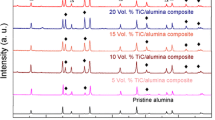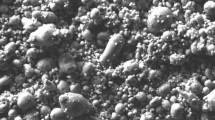Abstract
The mechanisms of densification and creep were examined during spark plasma sintering (SPS) of alumina doped with a low and high level of zirconia or yttria, over a temperature range of 1173–1573 K and stresses between 25 and 100 MPa. Large additions of yttria led clearly to in situ reactions during SPS and the formation of a yttrium-aluminum garnet phase. Dopants generally lead to a reduction in the densification rate, with substantial reductions noted in samples with ∼5.5 vol% second phase. In contrast to a stress exponent of n ∼ 1 for pure alumina, the doped aluminas displayed n ∼ 2 corresponding to an interface-controlled diffusion process. The higher activation energies in the composites are consistent with previous data on creep and changes in the interfacial energies. The results reveal a compensation effect, such that an increase in the activation energy is accompanied by a corresponding increase in the pre-exponential term for diffusion.






Similar content being viewed by others
References
Z.A. Munir, U. Anselmi-Tamburini, and M. Ohyanagi: The effect of electric field and pressure on the synthesis and consolidation of materials: A review of the spark plasma sintering method. J. Mater. Sci. 41, 763 (2006).
Z.A. Munir, D.V. Quach, and M. Ohyanagi: Electric current activation of sintering: A review of the pulsed electric current sintering process. J. Am. Ceram. Soc. 94, 1 (2011).
V. Viswanathan, T. Laha, K. Balani, A. Agarwal, and S. Seal: Challenges and advances in nanocomposite processing techniques. Mater. Sci. Eng., R 54, 121 (2006).
F. Wakai, T. Iga, and T. Nagano: Effect of dispersion of zirconia particles on creep of fine-grained alumina. J. Ceram. Soc. Jpn. 96, 1206 (1988).
P. Gruffel and C. Carry: Effect of grain size on yttrium grain boundary segregation in fine-grained alumina. J. Eur. Ceram. Soc. 11, 189 (1993).
J.D. French, J. Zhao, M.P. Harmer, H.M. Chan, and G.A. Miller: Creep of duplex microstructures. J. Am. Ceram. Soc. 77, 2857 (1994).
H. Yoshida, Y. Ikuhara, and T. Sakuma: High temperature creep resistance in rare-earth doped, fine grained alumina. J. Mater. Res. 13, 2597 (1998).
J. Cho, C.M. Wang, H.M. Chan, J.M. Rickman, and M.P. Harmer: Role of segregating dopants on the improved creep resistance of aluminium oxide. Acta Mater. 47, 4197 (1999).
R. Voytovych, I. Maclaren, M.A. Gulgun, R.M. Cannon, and M. Ruhle. The effect of yttrium on densification and grain growth in α-alumina. Acta Mater. 50, 3453 (2002).
M.A. Stough and J.R. Hellmann: Solid solubility and precipitation in a single crystal alumina-zirconia system. J. Am. Ceram. Soc. 85, 2895 (2002).
H. Yoshida, Y. Ikuhara, and T. Sakuma: High temperature plastic deformation related to grain boundary chemistry in cation-doped alumina. Mater. Sci. Eng., A 387–389, 723 (2004).
L.N. Satapathy and A.H. Chokshi: Microstructural development and creep deformation in an alumina-5% yttrium aluminium garnet composite. J. Am. Ceram. Soc. 88, 2848 (2005).
F. Wakai, T. Nagano, and T. Iga: Hardening in creep of alumina by zirconium segregation at the grain boundary. J. Am. Ceram. Soc. 80, 2361 (1997).
J. Wang and R. Raj: Estimate of the activation energies for boundary diffusion from rate-controlled sintering of pure alumina and alumina doped with zirconia or titania. J. Am. Ceram. Soc. 73, 1172 (1990).
J. Wang and R. Raj: Activation energy for the sintering of two-phase alumina/zirconia ceramics. J. Am. Ceram. Soc. 74, 1959 (1991).
P. Palmero, G. Fantozzi, F. Lomello, G. Bonnefont, and L. Montanaro: Creep behavior of alumina/YAG composites prepared by different sintering routes. Ceram. Int. 38, 433–441 (2012).
M. Yoshimura, T. Ojhi, M. Sando, Y.H. Choa, T. Sekina, and K. Niihara: Synthesis of nanograined ZrO2-based composite by chemical processing and pulsed electric current sintering. Mater. Lett. 38, 18 (1999).
Y. Takano, T. Ozawa, M. Yoshinaka, K. Hirota, and O. Yamaguchi: Microstructure and mechanical properties of ZrO2(2Y)-toughened Al2O3 ceramics fabricated by spark plasma sintering. J. Mater. Synth. Process. 7, 107 (1999).
L. Gao, H.Z. Wang, J.S. Hong, H. Miyamoto, K. Miyamoto, Y. Nishikawa, and S.D.D.L. Torre: SiC-ZrO2(3Y)-Al2O3 nanocomposites superfast densified by spark plasma sintering. Nanostruct. Mater. 11, 43 (1999).
J. Hong, L. Gao, S.D.D.L. Torre, H. Miyamoto, and K. Miyamoto: Spark plasma sintering and mechanical properties of ZrO2 (Y2O3)-Al2O3 composites. Mater. Lett. 43, 27 (2000).
D.D. Jayaseelan, N. Kondo, D.A. Rani, S. Ueno, T. Ojhi, and S. Kanzaki: Pulsed electric current sintering of Al2O3/3 vol% ZrO2 with constrained grains and high strength. J. Am. Ceram. Soc. 85, 2870 (2002).
F.F. Lange and M.M. Hirlinger: Hindrance of grain growth in Al2O3 by ZrO2 inclusion. J. Am. Ceram. Soc. 67, 164 (1984).
ASTM C373-88: Standard Test Method for Water Absorption, Bulk Density, Apparent Porosity and Apparent Specific Gravity of Fired Whiteware Products, (ASTM International, West Conshohocken, PA, 2006).
M.I. Mendelson: Average grain size in polycrystalline ceramics. J. Am. Ceram. Soc. 52, 443 (1969).
D. Chakravarty and A.H. Chokshi: Direct characterizing of densification mechanisms during spark plasma sintering. J. Am. Ceram. Soc. 97, 765 (2014).
L. Gao, Z. Shen, H. Miyamoto, and M. Nygren: Superfast densification in oxide-oxide ceramic composites. J. Am. Ceram. Soc. 82, 1061 (1999).
S. Ghosh, A.H. Chokshi, P. Lee, and R. Raj: A huge effect of weak dc electrical fields on grain growth of zirconia. J. Am. Ceram. Soc. 92, 1856 (2009).
C-S. Smith: Grains, phases and interfaces: An interpretation of microstructures. Trans. AMIE. 175, 15 (1948).
M.J.N.V. Prasad and A.H. Chokshi: Microstructural stability and superplasticity in an electrodeposited nanocrystalline Ni-P alloy. Acta Mater. 59, 4055 (2011).
E. Arzt, M.F. Ashby, and R.A. Verrall: Interface controlled diffusional creep. Acta Metall. 31, 1977 (1983).
V.T. Borisov, V.M. Golikov, and G.V. Shcherbedinski: On the relation between diffusion co-efficients and grain-boundary energies. Phys. Met. Metallogr. 17, 881 (1964).
R.L. Coble: Diffusion models for hot pressing with surface energy and pressure effects as driving forces. J. Appl. Phys. 41, 4798 (1970).
J.H. Schneibel and P.M. Hazzledine: The role of Coble creep and interface control in superplastic Sn-Pb alloys. J. Mater. Sci. 18, 562 (1983).
O.D. Sherby and J. Wadsworth: Superplasticity—Recent advances and future directions. Prog. Mater. Sci. 33, 169 (1989).
T.G. Langdon: A unified approach to grain boundary sliding in creep and superplasticity. Acta Metall. Mater. 42, 2437 (1994).
H. Cheng, H.S. Caram, W.E. Schiesser, J.M. Rickman, H.M. Chan, and M.P. Harmer: Oxygen grain-boundary transport in polycrystalline alumina using wedge-geometry bilayer samples: Effect of Y-doping. Acta Mater. 58, 2442 (2010).
A.H. Heuer: Oxygen and aluminum diffusion in α-alumina. How much do we really understand?J. Eur. Ceram. Soc. 28, 1495 (2008).
A.H. Chokshi: The densification, superplastic deformation and fracture characteristics of a 3 mol% yttria stabilized zirconia. In Progress in Advanced Materials and Mechanics, W. Tzuchiang and T-W. Chou eds. (Peking University Press, China, 1996); 381–386.
A.H. Chokshi: Diffusion, diffusion creep and grain growth characteristics of nanocrystalline and fine-grained monoclinic, tetragonal and cubic zirconia. Scr. Mater. 48, 791 (2003).
R.M. Cannon, W.H. Rhodes, and A.H. Heuer: Plastic deformation of fine grained alumina: I. Interface controlled diffusional creep. J. Am. Ceram. Soc. 63, 46 (1980).
G. Gottstein and L.S. Shvindlerman: The compensation effect in thermally activated interface processes. Interface Sci. 6, 265 (1998).
S.V. Divinski and H. Edelhoff: Diffusion and segregation of silver in copper ∑5(310) grain boundary. Phys. Rev. B 85, 144104 (2012).
M.J. Kim, Y.K. Cho, and D.Y. Yoon: Kinked grain boundaries in alumina doped with Y2O3. J. Am. Ceram. Soc. 87, 717 (2004).
P.R. Cantwell, M. Tang, S.J. Dillon, J. Luo, G.S. Rohrer, and M.P. Harmer: Grain boundary complexions. Acta Mater. 62, 1 (2014).
S.K. Behera, P.R. Cantwell, and M.P. Harmer: A grain boundary mobility discontinuity in reactive element Zr-doped alumina. Scr. Mater. 90–91, 33 (2014).
ACKNOWLEDGMENTS
This work was supported by the Department of Science and Technology. We gratefully acknowledge the support and useful discussions with Dr. G. Sundararajan. One of us (AHC) is also grateful to Professor Laszlo Toth for support during a sabbatical leave at the University of Lorraine, Metz.
Author information
Authors and Affiliations
Corresponding author
Rights and permissions
About this article
Cite this article
Chakravarty, D., Chokshi, A.H. Influence of yttria and zirconia additions on spark plasma sintering of alumina composites. Journal of Materials Research 30, 1148–1156 (2015). https://doi.org/10.1557/jmr.2015.72
Received:
Accepted:
Published:
Issue Date:
DOI: https://doi.org/10.1557/jmr.2015.72




